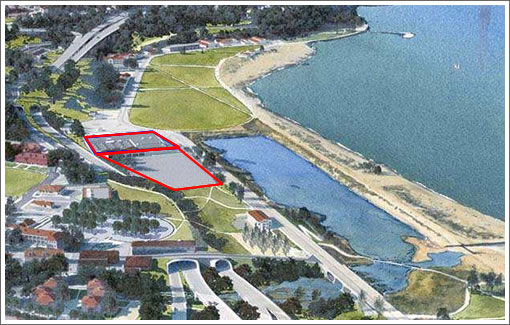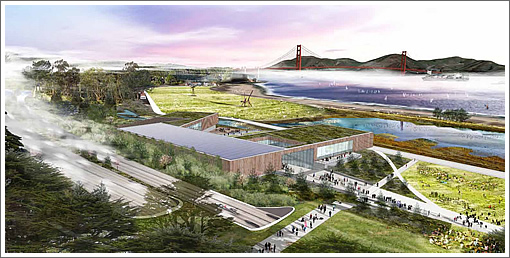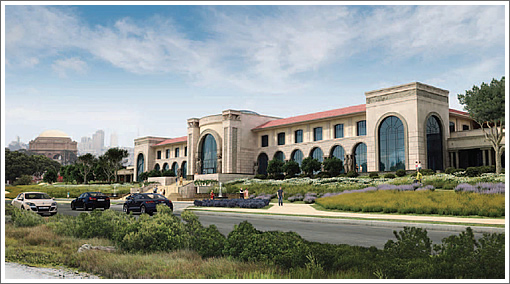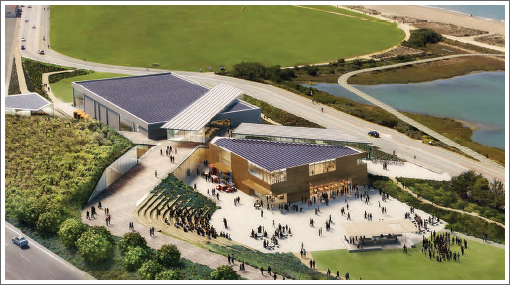
Reaffirming its “strong commitment to accomplishing an outcome in the Mid-Crissy area that will protect the park and bring long-term benefit to the Presidio and its visitors,” the Presidio Trust Board of Directors has exercised its option of “not necessarily selecting any team” to redevelop the former Commissary and current Sports Basement site across from Crissy Field and has asked the three finalists to revise and resubmit their proposals.
“The Board believes that there is tremendous thought, creativity, and potential in the proposals offered by the three finalists. The Board also understands that it holds the option of not necessarily selecting any team at this point. Such is the importance of the site that we take seriously our duty to do right by it, even if that means waiting. That said, we are very enthusiastic about the proposals, and appreciate the wonderful work that has gone into them, the generosity behind them, and the promise they hold for enhancing the Presidio.
We have sought to engage in a fair and open public process – from the development of the Mid-Crissy design guidelines, to the release, in November 2012, of the Request for Concept Proposals and the subsequent Request for Proposals. In the interest of transparency, the Board would like to share its observations at this point in the process.”
Focusing on “achieving program clarity, ensuring the building’s compatibility with the Presidio, and understanding how economic viability will be assured,” the Board’s observations and feedback for the three finalists to consider should they elect to revise and resubmit a proposal:
Feedback for The Bridge/Sustainability Institute Team:

An amazing architectural group has teamed up with a compelling programmatic visionary around the issues of sustainability. We agree with the proponents that sustainability is “perhaps the defining issue of our time,” and appreciate the blending of the physical building and the program in an effort to advance a holistic understanding of sustainability. We also see a clear connection between the sustainability issue and our work at the Presidio – in environmental restoration, historic preservation, environmental education, and financial sustainability. We are concerned, however, about the institutional capacity of the team to, without significant funds or fundraising help from the Trust, deliver and sustain the project financially. We encourage the WRNS/Chora team to bring more clarity to the question of who might fund the building and early programming, and what institution will be created to operate and sustain the Bridge. While the building is “light on the land,” it is also too large and we urge some consolidation of the building program.
Feedback Lucas Cultural Arts Museum (LCAM) Team:

The Board recognizes and appreciates both the generosity and opportunity represented in George Lucas’s offer to build a cultural arts museum in the Presidio. We are enthusiastic about the state-of-the-art exhibits, strong community programming, and notable art collection that is offered in the proposal. The Trust is particularly excited about the potential of exceptional educational programming to draw diverse audiences to the museum and the greater Presidio. Despite this, we have significant issues with the proposed building – its massing and height, and its architectural style – and believe should be redesigned to be more compatible with the Presidio. We would also like to understand more fully the potential role of the Trust in partnership with LCAM, particularly in creating programmatic connections that would add value to other park programs throughout the Presidio.
Feedback for the Presidio Exchange (PX) Team

There is no question about the level of expertise, design excellence and community engagement that the Golden Gate National Parks Conservancy brings to each project it undertakes. The Presidio, and the broader Golden Gate National Recreation Area, is replete with examples of the Conservancy’s good work and of its ethos of partnership in the public interest. The Conservancy’s approach to programming at the PX – intended to be varied, flexible and relevant over time to park audiences – is fascinating. Yet, these attributes also make it harder to understand what the PX is truly striving for programmatically. What is the master narrative? Is there an overall theme, or focus, that can be better articulated so that the Trust will understand how PX programming will differ from/complement existing or planned programs, such as the Presidio Visitor Center, Heritage Center, and Crissy Field Center?
Revised proposals are due by January 3, 2014 with a public meeting to discuss the revisions to be scheduled for later that month. The Presidio Trust Board will indicate a direction for the Mid-Crissy site following the public meeting in January.
So basically their feedback is:
Bridge/Sustainability: Cute pipe dream, no money attached
Lucas: Too big and ugly
Presidio Exchange: Uhh, what’s the point of this again?
The smart money says Lucas hires a new architect and closes the deal.
The only problem I had with Lucas was the building, so I agree with the trust that they need to go back and redesign. The faux beaux (fo-bo?) design did not fit in at all.
This is such a shame. The George Lucas design evoked a sense of classicism that is so, so, so missing from most of the new proposals in San Francisco. Truly tied the building into the neighborhood’s history of being the site of the World’s Fair. An elegant, thoughtful, gracious building.
I vote for keeping the Sports Basement as is. Of all the alternatives it’s the most consistent with contemporary uses and enjoyment of the Presidio.
[Editor’s Note: The Sports Basement’s New Presidio Home.]
Can we get rid of the ugly “art” by Mark di Suvero now?
Lucas will build his museum in Chicago (where he lives part time). You heard it here first!
Agree with Hawkins, I thought the Lucas design was a reasonable tie-in with the Palace of Fine Arts… but I do think it could be scaled back (put some of the exhibits underground, a la the Louvre or the Legion of Honor?) and it’d be an even better fit – and win – for the Presidio.
I agree with Hawkins, there’s nothing wrong with the Lucas proposal and I in fact prefer it to the other two.
Sustainability-driven design, or what I like to call “LEED-chasing” seems like it’s becoming it’s own architectural style (to this ‘armchair’ observer). You can look at a project’s renderings and you know right away that they’re going for a certification.
So we’re to believe that the the Presidio Exchange and The Bridge/Sustainability Institute Team proposals are “more compatible with the Presidio” because Lucas’ proposal was the only one called out for redesign? Please. That’s just insulting.
They should eliminate the cartoonish proposal by Lucas.
It is so out of touch with reality, and does not reflect anything about living in the 21st century. His design is what it is ONLY because he is the master of set design and storytelling, and has the money to hire a firm who will do exactly as he says.
Terrible design. Reject it. Select a modern solution that speaks and reflects of living in 2013, not 1913.
Lucas has already publicly announced that if his project encounters “difficulties” at the Presidio, he has been “talking to Rahm” about building in Chicago instead. I think this may push him to withdraw.
Finally Futurist actually says something critical about a design!
I agree, that proposal was a monstrous ode to Gaud.
Not that I think it is out of scale, I think a large scale building would be great, if you consider the scale of the nearby Golden Gate Bridge and Palace of Fine Arts.
The problem with people like Fisher and Lucas is that they think their names are Whitney and Guggenheim. They are not, and the Presidio of SF is not the upper east side of Manhattan.
I think Lucas should give his collection and the money he promised to go with it to the Fine Arts Museums, assuming they will take it.
At the same time, Lucas, with his money (a lot) could hire the best of the best world class firms to design a world class museum worth of that location.
I’ve met him, I’ve done some design work for him and he is deeply attached to ONLY classical/faux/historical design.
I don’t think it’s cartoonish. In that case, we should tear down this huge pseudo ruin in the background. It’s not 1913 architecture, it’s 2313 neo-classical farcical architecture. But I like it. It’s eye candy.
What Lucas hasn’t understood is that memorabilia or collectibles presented in a permanent location can be called 2 things:
– A family museum if the owner is deceased (like Disney’s)
– A monument to tackiness if the owner is alive
If George Lucas wants to get this built, he knows exactly what to do 😉
What do people think about the long ball… Lucas at The Palace of Fine Arts.
SF needs a other museum like it needs another soup kitchen.
How about something a little more fun, or is that still legal there?
Whitney and Guggenheim were the Lucas and Gates of their day – and when those museums were put in the neighborhood wasn’t exactly “urban marsh” (or whatever you’d call Crissy Field), but they were solidly residential, and the museums were controversial.
Lets not forget that the Presidio is a National Park. National Parks have a specific role as stated in the Organic Act establshing the NPS:
“The service thus established shall promote and regulate the use of the Federal areas known as national parks, monuments, and reservations hereinafter specified by such means and measures as conform to the fundamental purpose of the said parks, monuments, and reservations, which purpose is to conserve the scenery and the natural and historic objects and the wild life therein and to provide for the enjoyment of the same in such manner and by such means as will leave them unimpaired for the enjoyment of future generations.”
That is, the ONLY purpose of a national park is to preserve the resource FOR WHICH THE PARK WAS DESIGNATED in perpetuity, for the enjoyment of all present and future people.
The purpose of this national park then is not to provide free land for individuals or insitutions who want to construct art galleries or any other cultural facility unrelated to the park but rather to enhance the understanding and enjoyment of the basic resource: in this case, a historic military base in a woodland setting.
Jim – Are you sure it’s a National Park? I believe most (if not all) of it falls under the jurisdiction of the GGNRA. I’ve always understood that the Presidio is a Federal Trust, unless that has changed due to the condition that the Presidio be financially self-sufficient by a certain year (I thought it was 2013).
Whitney and Guggenheim were established for generations before the museum. It was not in the lifetime of the founder of the fortune. There was controversy but they could look to the support of their similarly-placed friends, and they were proposing serious museums, unlike Lucas, not pop culture.
Fisher’s collection is very serious but his ambition for his own named institution in the Presidio was misguided; that all worked out well for us.
Yeah, the Presidio is not a national park. 20% of its land is maintained by the National Park Service (the coastal portions, mostly) and the remaining 80% is managed by the Presidio Trust, a specific entity set up by Congress to keep the Presidio self-sustaining monetarily.
It is not to be confused with actual national parks like Yosemite or Yellowstone – very, very different structure and intent.
Presidio Trust Manages 80% of the Presidio (the interior), and the National Park Service manages 20% (the waterfront) as a part of the Golden Gate National Recreation Area. It is not actually a National Park in the sense that Yellowstone or Yosemite are (or Pinnacles, for that matter). It is a unique hybrid.
Sounds like Lucas needs to hire Robert Venturi for something along the lines of the Sainsbury Wing for a modern design with a nod towards Classicism.
Excerpts From Wikipedia
“The Golden Gate National Recreation Area (GGNRA) is a U.S. National Recreation Area protecting 80,002 acres (32,376 ha) of ecologically- and historically-significant landscapes surrounding the San Francisco Bay Area.…GGNRA is managed by the National Park Service and is one of the most visited units of the National Park system in the United States…The park is as diverse as it is expansive; it contains famous tourist attractions such as …the Presidio of San Francisco.”
“The Presidio of San … is a park and former military base on the northern tip of the San Francisco Peninsula in San Francisco, California, and is part of the Golden Gate National Recreation Area.
“On October 1, 1994, it was transferred to the National Park Service, ending 219 years of military use and beginning its next phase of mixed commercial and public use.
In 1996, the United States Congress created the Presidio Trust to oversee and manage the interior 80% of the park’s lands, with the National Park Service managing the coastal 20%.[8] In a first-of-its-kind structure, Congress mandated that the Presidio Trust make the Presidio financially self-sufficient by 2013, which it achieved 8 years earlier.”
“After a hard-fought battle, the Presidio averted being sold at auction and came under the management of the Presidio Trust, a US Government Corporation established by an act of Congress in 1996.
The Presidio Trust now manages most of the park in partnership with the National Park Service. The Trust has jurisdiction over the interior 80 percent of the Presidio, including nearly all of its historic structures. The National Park Service manages coastal areas. Primary law enforcement throughout the Presidio is the jurisdiction of the United States Park Police.”
“One of main objectives of Presidio Trust’s program was achieving financial self-sufficiency by fiscal year 2013. Thanks to rents from residential and commercial tenants, this happened well ahead of schedule, in 2006.
“…The Presidio Trust Act calls for “preservation of the cultural and historic integrity of the Presidio for public use.” The Act also requires that the Presidio Trust be financially self-sufficient by 2013. These imperatives have resulted in numerous conflicts between the need to maximize income by leasing historic buildings, and permitting public use despite most structures being rented privately. Further differences have arisen from the divergent needs of preserving the integrity of the National Historic Landmark District in the face of new construction, competing pressures for natural habitat restoration, and requirements for commercial purposes that impede public access. “
Excerpts From the Golden Gate University Lsw Review,Volume 28 Issue 3 Notes and Comments
9-22-2010 “The Presidio Trust and our National Parks: Not a Model to be Trusted” by
Johanna H. Wald
“The law requires that the Secretary of the Interior, or his or her designee, be a member of the Trust Board. This and other membership requirements of the Board are intended to help establish strong resource protection representation among the individuals responsible for the Presidio’s fate. Second, the law provides that, for purposes of carrying out its mandate, the Trust is to be considered a successor in interest to the Park Service with respect to compliance to the National Environmental Policy Act and all other environmental laws as well as National Historic Preservation Acts.93 In effect, the Trust must follow all of the same statutes that govern the Park Service in its administration of other parks and must include the public in its decision making. In addition, the Trust must work closely with the Interior Department and the Park Service in a number of key areas.”
“The Trust is, for example, required to comply with GGNRA park “purposes” and with “the general objectives of the General Management Plan” for the Presidio.94It must consult with the Secretary of the Interior in preparing its management program as well as in developing its rules and regulations.95The Trust, too, is responsible for cooperating with the Park Service to assure visitor access, interpretation and educational programs in lands it administers.96 Finally, Representative Pelosi sought to protect the lands that were not specifically related to real estate management, but were nonetheless administratively transferred to the Trust – i.e. open space lands and the Presidio’s historic forest.”
“Specifically, the law requires the Trust to maintain at least the current amount of open space at the Presidio and prohibits it from disposing of or conveying fee title to any real property under its administration.97”
“Additionally, the Trust is encouraged tohave high public use potentia1.98 Additionally, the Trust is encouraged to transfer administration back to the Secretary of the Interior, of any lands which are not needed by it and which legislation provided only for transfer of buildings to the trust, as these were the marketable resource. The 104th Congress, however, sought – and obtained – a much larger transfer.99 It seems likely that, as open space has little rental value and requires management, the Trust will move quickly to place these lands back under the jurisdiction of the agency that clearly can protect and manage them.”
Longest post ever? Maybe.
Still doesn’t make the Presidio a National Park.
This is not my back yard, but I’m all for keeping status quo. The sports basement as a social hub for outdoor enthusiasts has a ton of value. Why go into a museum when you have the best view in the world?
“Why go into a museum when you have the best view in the world?” EXACTLY! It would be like going to the Grand Canyon but being told that instead of exploring the actual place, you should “go inside our new museum-visitors center instead”. I could see where some of the old military structures adjacent to The Warming Hut could be converted into a visitors space showing information about the history and landscape for a lot less money.
I feel the Warming Hut already does a great job for visitors with providing information as well as selling guides, food, gear, etc.
Putting a museum in a park is crazy. It would be like putting the Met in Central Park. It’d never work.
“Putting a museum in a park is crazy. It would be like putting the Met in Central Park. It’d never work.”
Yeah, like putting the DeYoung in Golden Gate Park. Totally crazy, and the architecture of the building fits in so well with the trees.
Let’s face it, the Lucas proposal is the only one that has funding. Further, it is the only one that will actually attract more visitors to the park and generate revenue to fund other projects. The other two proposals have zero to insufficient funding to even break ground, let alone actually realize their vague, pie-in-the-sky goals. The Sports Basement is already moving, so keeping it there in a rotting building is not going to work.
The Lucas proposal looked like a fancied up big box store. It has nothing to do with anything in the area other than whatever behemoth was erected at the nearest suburban mall.
And I actually think the exhibits would be a nice gesture towards entertaining the masses of tourists. But not in this! Ugh.
This could be a Home Depot or Wal-Mart in Texas.
Shameful.
Don’t worry San Francisco, 69 year old Lucas is making public statements again that his museum project is moving to Chicago, his other home. Everyone can stop fretting about the “terrible” architecture, and his art and illustration collection that some have said is of “little merit” and poor quality.
Lucas can easily build in Chicago which is a city that is somehow able to do big projects very well and much quicker than San Francisco. The collection of incredible museums already in place in Chicago will not have to worry about the new competition and San Francisco can spend the next 30 years fighting about what is an appropriate museum for such a “world class” city.
For me, it’s not about what is an “appropriate” museum. It’s about the faux-historical architecture.
Chicago has a great history of outstanding, modern, authentic architecture.
I think he will encounter resistance there as well, if he sticks to this stage-set design.
UPDATE: National Park Service Pans Lucas’ Presidio Museum Proposal, seeks several year deferral of any decision for the site.